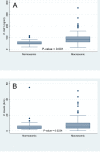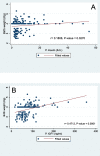Fetal macrosomia, fetal insulin, and insulin-like growth factor- 1 among neonates in Lagos, Nigeria: A case-control study
- PMID: 36001625
- PMCID: PMC9401182
- DOI: 10.1371/journal.pone.0266314
Fetal macrosomia, fetal insulin, and insulin-like growth factor- 1 among neonates in Lagos, Nigeria: A case-control study
Abstract
Purpose: Fetal macrosomia is associated with perinatal injuries. The purpose of this study was to assess the relationship between fetal insulin, insulin-like Growth factor-1(IGF-1), and macrosomia in a resource-limited setting.
Method: This was a case-control study at tertiary and secondary health facilities in Lagos, Nigeria. One hundred and fifty mother-neonate pairs were recruited, and their socio-demographic and obstetric history was recorded. Fetal cord venous blood was collected at birth, and neonatal anthropometry was measured within 24hrs of life. Insulin and IGF-1 assay were measured with Enzyme-Linked Immunosorbent Assay (ELISA). Pearson's Chi-square was used to assess the association between categorical variables and macrosomia. Spearman's rank correlation of insulin, IGF-1, and fetal anthropometry was performed. Multivariable logistic regression was used to evaluate the association of insulin and IGF-1 with fetal birth weight. A statistically significant level was set at P-value < 0.05.
Results: Macrosomic neonates had mean fetal weight, fetal length, and occipitofrontal circumference (OFC) of 4.15±0.26kg, 50.85±2.09cm and 36.35± 1.22cm respectively. The median Insulin (P = 0.023) and IGF-1 (P < 0.0001) were significantly higher among macrosomic neonates as compared to normal weight babies. Maternal BMI at birth (p = 0.003), neonate's gender (p < 0.001), fetal cord serum IGF-1 (p < 0.001) and insulin assay (P-value = 0.027) were significant predictors of fetal macrosomia. There was positive correlation between cord blood IGF-1 and birth weight (r = 0.47, P-value < 0.001), fetal length (r = 0.30, P-value = 0.0002) and OFC (r = 0.37, P-value < 0.001).
Conclusion: Among participating mother-neonate dyad, maternal BMI at birth, neonate's gender, and fetal cord serum IGF-1 and serum insulin are significantly associated with fetal macrosomia.
Conflict of interest statement
The authors have declared that no competing interests exist.
Figures
References
-
- Reynolds CM, Perry JK, Vickers MH: Manipulation of the Growth Hormone-Insulin-Like Growth Factor (GH-IGF) Axis: A Treatment Strategy to Reverse the Effects of Early Life Developmental Programming. International journal of molecular sciences 2017, 18(8). doi: 10.3390/ijms18081729 - DOI - PMC - PubMed
MeSH terms
Substances
LinkOut - more resources
Full Text Sources
Miscellaneous



